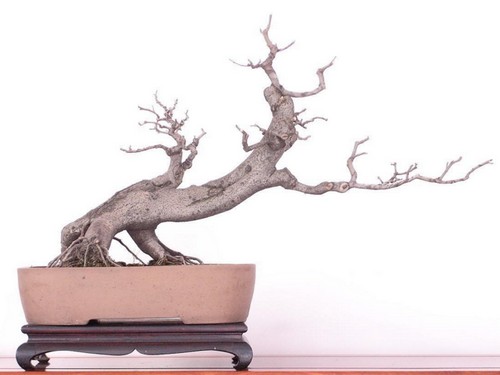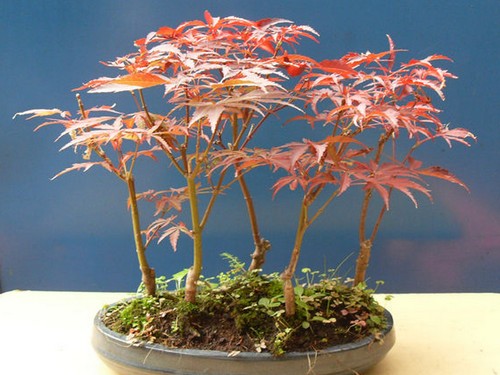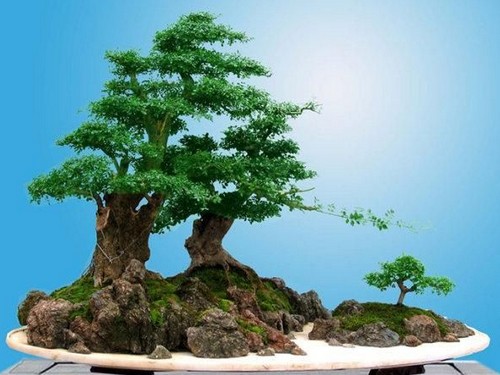The modeling of the branches of white wax bonsai
White wax is a fast-growing tree species with exuberant growth. after one year's cultivation and pruning of basal branches, most of the branches can be pruned and stored in the second year, except for a few terminal transitional branches, floating branches and falling branches which are specially lengthened and thickened.

In the initial stage, the first and second branches are mainly tied (pulled), supplemented by shearing, and in the later stage, after the branches are basically formed, they are mainly sheared, supplemented by pulling, and generally pruned by pruning techniques that go up first and then down, suppressing the strong and helping the weak.
First up and then down: that is, the upper part of the tree is cut first, then the middle branch is cut after a period of time, and then the lower branch is cut every few days. For the same branch, the ascending branch is cut first until the parallel and descending branches are thicker than the upper branches.
Suppressing the strong and helping the weak: the strong branches in the upper part should be cut for several days first, and then cut when the weak branches grow to a certain thickness. Objective to match the thickness of the branch to its position.
For particularly prosperous trees, in addition to the usual attention to control, can be carried out to remove leaves and cut branches.
After Frosts Descent in autumn, the leaves withered by frost and the branches were exposed, which was very advantageous to observe the trend of the branches (pieces), interspersed back and forth, high and low, and position shape. At this time, the branches can be carefully trimmed and tied. Can be cut in place with scissors to complete, cut not in place, can be wound with aluminum wire bending pull in place; some branches too high or direction, position is not good, with aluminum wire or rope pull in place.
The opposite branch and the frog leg branch should be paid special attention to; the opposite branch should be staggered and cut off on the fixed branch and the first and second branch; the frog leg branch can be cut short or changed into an inflection branch at the same time.
Time: 2019-06-12 Click:
- Prev

Seedling raising technique of red maple bonsai
Red maple is a valuable foliage tree, so it is often appreciated by potted plants. When potted, two portions of garden soil and two portions of rotten leaf soil and one part of sand can be used to form culture soil. Japanese red maple trees are transplanted from February to March, and the growing season requires picking leaves and carrying soil balls. Daily watering should be wet between dryness and dryness to prevent excessive dryness or wetness.
- Next

How to apply fertilizer scientifically to white wax bonsai
Thin fertilizer is applied frequently in the growing season. In order to facilitate tree absorption and avoid waste of fertilizer liquid, it should be applied once every 5-7 days. The fertilization time is generally carried out when the basin soil is dry in the afternoon on a sunny day, and the leaves are watered after application. When the soil is wet in cloudy and rainy days, the roots are not easy to breathe, and the roots are not easily absorbed after fertilization; big sun: even in cold hot days
Related
- Fuxing push coffee new agricultural production and marketing class: lack of small-scale processing plants
- Jujube rice field leisure farm deep ploughing Yilan for five years to create a space for organic food and play
- Nongyu Farm-A trial of organic papaya for brave women with advanced technology
- Four points for attention in the prevention and control of diseases and insect pests of edible fungi
- How to add nutrient solution to Edible Fungi
- Is there any good way to control edible fungus mites?
- Open Inoculation Technology of Edible Fungi
- Is there any clever way to use fertilizer for edible fungus in winter?
- What agents are used to kill the pathogens of edible fungi in the mushroom shed?
- Rapid drying of Edible Fungi

